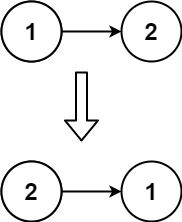剑指 Offer II 024. 反转链表
题目描述
给定单链表的头节点 head ,请反转链表,并返回反转后的链表的头节点。
示例 1:

输入:head = [1,2,3,4,5] 输出:[5,4,3,2,1]
示例 2:

输入:head = [1,2] 输出:[2,1]
示例 3:
输入:head = [] 输出:[]
提示:
- 链表中节点的数目范围是
[0, 5000] -5000 <= Node.val <= 5000
进阶:链表可以选用迭代或递归方式完成反转。你能否用两种方法解决这道题?
注意:本题与主站 206 题相同: https://leetcode.cn/problems/reverse-linked-list/
解法
方法一
Python3
# Definition for singly-linked list.
# class ListNode:
# def __init__(self, x):
# self.val = x
# self.next = None
class Solution:
def reverseList(self, head: ListNode) -> ListNode:
pre, p = None, head
while p:
q = p.next
p.next = pre
pre = p
p = q
return pre
Java
/**
* Definition for singly-linked list.
* public class ListNode {
* int val;
* ListNode next;
* ListNode(int x) { val = x; }
* }
*/
class Solution {
public ListNode reverseList(ListNode head) {
ListNode pre = null, p = head;
while (p != null) {
ListNode q = p.next;
p.next = pre;
pre = p;
p = q;
}
return pre;
}
}
C++
/**
* Definition for singly-linked list.
* struct ListNode {
* int val;
* ListNode *next;
* ListNode() : val(0), next(nullptr) {}
* ListNode(int x) : val(x), next(nullptr) {}
* ListNode(int x, ListNode *next) : val(x), next(next) {}
* };
*/
class Solution {
public:
ListNode* reverseList(ListNode* head) {
ListNode* pre = nullptr;
ListNode* p = head;
while (p) {
ListNode* q = p->next;
p->next = pre;
pre = p;
p = q;
}
return pre;
}
};
Go
/**
* Definition for singly-linked list.
* type ListNode struct {
* Val int
* Next *ListNode
* }
*/
func reverseList(head *ListNode) *ListNode {
var pre *ListNode
for p := head; p != nil; {
q := p.Next
p.Next = pre
pre = p
p = q
}
return pre
}
JavaScript
/**
* Definition for singly-linked list.
* function ListNode(val, next) {
* this.val = (val===undefined ? 0 : val)
* this.next = (next===undefined ? null : next)
* }
*/
/**
* @param {ListNode} head
* @return {ListNode}
*/
var reverseList = function (head) {
let pre = null;
for (let p = head; p; ) {
let q = p.next;
p.next = pre;
pre = p;
p = q;
}
return pre;
};
C#
/**
* Definition for singly-linked list.
* public class ListNode {
* public int val;
* public ListNode next;
* public ListNode(int val=0, ListNode next=null) {
* this.val = val;
* this.next = next;
* }
* }
*/
public class Solution {
public ListNode ReverseList(ListNode head) {
ListNode pre = null;
for (ListNode p = head; p != null;)
{
ListNode t = p.next;
p.next = pre;
pre = p;
p = t;
}
return pre;
}
}
Swift
/**
* Definition for singly-linked list.
* public class ListNode {
* public var val: Int
* public var next: ListNode?
* public init(_ val: Int) {
* self.val = val
* self.next = nil
* }
* }
*/
class Solution {
func reverseList(_ head: ListNode?) -> ListNode? {
var prev: ListNode? = nil
var current = head
while current != nil {
let next = current?.next
current?.next = prev
prev = current
current = next
}
return prev
}
}
方法二
Java
/**
* Definition for singly-linked list.
* public class ListNode {
* int val;
* ListNode next;
* ListNode(int x) { val = x; }
* }
*/
class Solution {
public ListNode reverseList(ListNode head) {
if (head == null || head.next == null) {
return head;
}
ListNode res = reverseList(head.next);
head.next.next = head;
head.next = null;
return res;
}
}